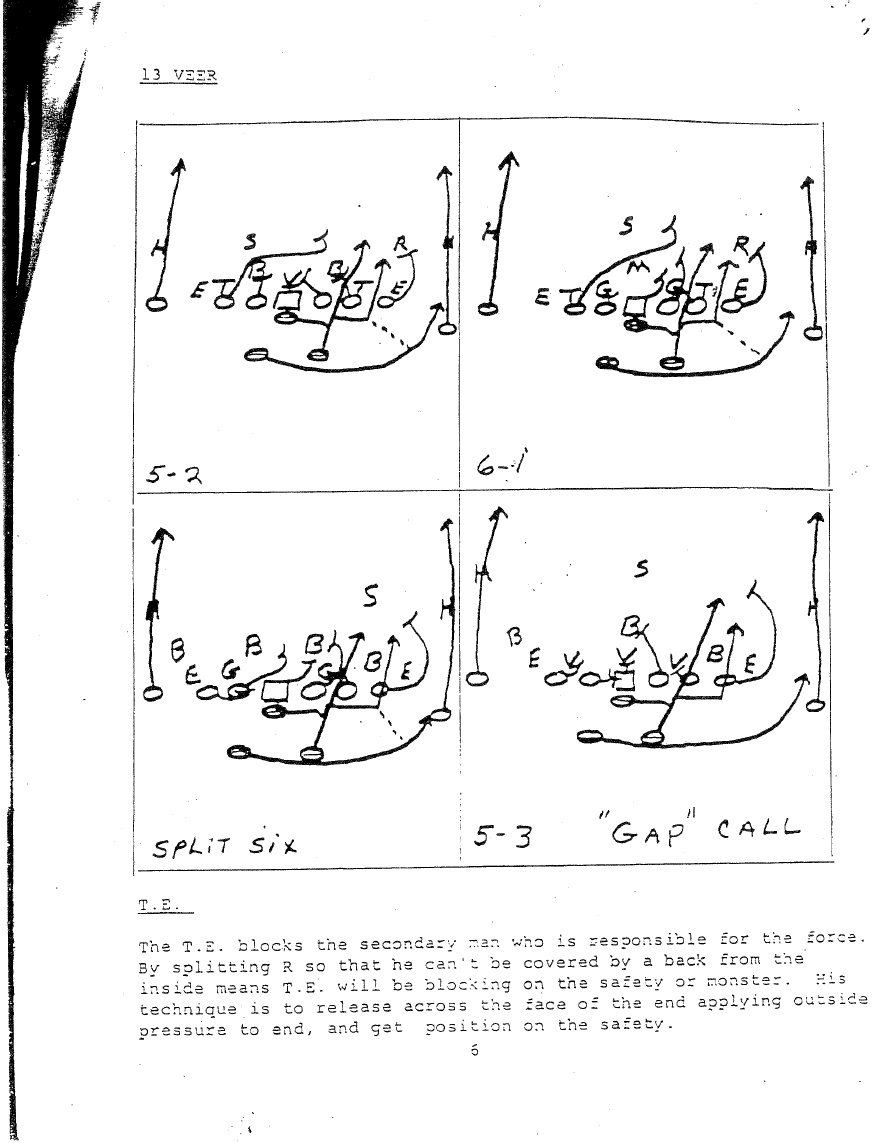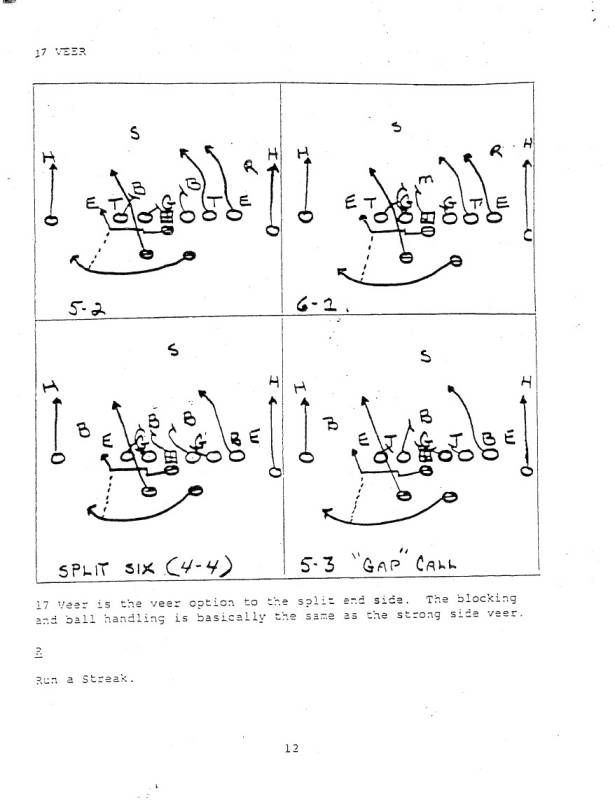Option Football Offense: Old School to New School
Welcome to another installment of Chalk Dust X’s and O’s.
The option oriented ground attack is almost as old as the game of football itself, initially sprouting its wings under the vaunted Single Wing attack before moving onto such formations as the Power T, Split T, and Wishbone then modern day formations with the Flexbone, staggered Bone at Army, and various Shotgun formations.
The Early Background of the Option
The option attack initially started out of the Split T Formation as the QB was allowed to receive the direct snap from center. As a result of having two running backs to his left and right, he was given the ability to fake the handoff to one back and keep it or lateral it to the other running back. The Shotgun Zone Read plays have largely become similar to this formation and play, just lacking the third option on the given play instead being a double option.
Created by Don Faurot, Jim Tatum and Bud Wilkinson would eventually bring the Split T option offense to Oklahoma where Wilkinson would win 47 straight games, including two National Titles in 1953 and 1957.
The Introduction of the Veer Option
This offense is largely credited to the mind of Bill Yeoman, whom introduced the offense to the University of Houston in the mid 1960s. The Veer is largely the staple of the “triple” option play by having the HB, QB Keeper, and HB pitch all formatted to one individual play while based on reading a sole defensive player.
As seen in the below image, fans of the modern day option offenses will instantly recognize this. Take note of the fact that the Veer is run out of the traditional 2 Back Pro formation. The quarterback reads the defensive end. If he crashes down towards the HB, the QB has the option to keep it and take it towards the outside. If the DE stays where he is, the QB can hand off to the HB like a normal dive run up the middle further aided by the double team blocking from the center and offensive guard.

Credit to Chris Brown’s scribd collection
The image below is the outside veer variant as opposed to the above inside veer. The QB will be reading the unblocked outside DT. If the DT crashes inside, the QB can keep the ball moving down the line of scrimmage and keeping or pitching based off what the DE does. If the DT stays where he is, the QB can treat the play like a normal dive run up the middle.

Credit to Chris Brown’s scribd collection
The evolution of the popular Zone Read play in college football and at the NFL level has its roots in the Veer option largely due to the reading, usually, of the defensive end on the line of scrimmage. The largest difference is that the play has transitioned to more of a single wing play as the quarterback reads the defensive end and decides whether to hand off or keep the ball. The biggest difference is that the Veer, especially the inside Veer, would often read the alignment and/or play of the DT and sometimes even the middle linebacker or inside linebacker.
The Inverted Veer play that has been popping up over the last decade or so is a double option attack where the QB reads the DE on the outside sweep run by the HB. If the DE bites and goes with the HB, the QB can keep it for a run up the middle. If the DE stays, the QB can hand off and let the HB run the ball around the offensive tackle towards the outside.
Introduction and Evolution of the Wishbone Formation
Despite roots as far back as the late 1950’s, Emory Bellard is largely credited with bringing the Wishbone formation to the college football landscape in 1968 after being named offensive coordinator of the Texas Longhorns. The Wishbone, in many ways, was partially adopted out of the two back formation and incorporated the fullback directly behind the quarterback. The Wishbone’s biggest strength was that it now forced the defense to account for not only the quarterback and two halfbacks in the option game, but also the fullback. If utilized with two wide receivers, it made for a very potent play-action formation as well for the threat of vertical downfield passing.
The offense was immediately revolutionary being installed at Alabama under Bear Bryant and Oklahoma under Chuck Fairbanks and Barry Switzer. In an interesting note, Bellard further tweaked the Wishbone into an early forefather of the Flexbone utilizing one of the Halfbacks in the wing spot, lining him on the hip of the offensive tackle or tight end.
The Wishbone under Oklahoma, for example, was kept rather simple which makes its results far more impressive and gives more insight as to how dominant pure execution could be. That includes setting a still standing record by averaging 472.4 rushing yards per game in 1971. Oklahoma utilized Traps, Counters, Power, and Offtackle runs in addition to their vaunted option attack.
Introduction of the I-Formation aka I-Bone Offense
I touched on this in much more detail in my Tom Osborne I-Bone Article but at the start of 1980, Tom Osborne started implementing more option elements out of the I-Formation. The most notable inclusions were the speed option, a double option where the QB darts outside and keeps or pitches based off the DE or OLB, and the triple option.
As a result of the power running game of the I-Formation, Tom Osborne was able to build the option game off the downhill power scheme without risking injury to his quarterback over and over.
Introduction and Evolution of the Flexbone Formation
Paul Johnson, currently the head coach at Georgia Tech, really started experimenting with the Flexbone offense at Georgia Southern in the mid-1980s before arriving at Hawai’I as offensive coordinator in 1987.
The Run-and-Shoot offense was the big deal during the 1980s and Paul Johnson’s evolution introduced the double slot formation to the option attack. However, instead of having small slot wide receivers, Paul Johnson utilized them as dual running back and wide receiver threats. Not only did Paul Johnson proceed to incorporate more run-and-shoot passing patterns in the passing game, but he also incorporated the I-Formation look but done radically differently. The key was the motioning of the slot HB, which allowed the handoff to be done at the top of the eventual I-Formation and forced defenders to have to account for the motion man as well as any misdirection off the motion too.
Paul Johnson would ride this new formation to dominant success at Georgia Southern, Hawai’I, Navy which kept the offense after Johnson left, and head coaching stints at Georgia Southern and Navy again. Georgia Southern recently re-installed the Flexbone offense to great success as have schools such as Wofford along with Army and Air Force. Upon being named head coach of Georgia Tech in 2007, Paul Johnson would notably defeat Georgia 45-42 in 2008.
It’s really interesting to read the notes that Paul Johnson and other Option coaches jot down. The quarterbacks really are the ones that make these offenses go and a lot is put on their plate in terms of making the proper read based on defensive alignment and then making the correct read on the fly if they keep the ball.
Worth noting is this Georgia Southern playbook from the 1990s, credit to footballxos.com: Georgia Southern 1990’s Option Playbook. In particular, pages 13-22 document what is expected of the quarterback in such an offensive system and are essential reading for anybody interesting in the nitty gritty of option execution from the QBs eyes.
A small key piece of knowledge, for example, is the note that the QB must assume pitching off the #3 read (usually the DE or LB on the end line of scrimmage) until the defender doesn’t let him pitch as Johnson states, “When the quarterback takes the snap and comes down the line of scrimmage he tells himself, ‘Pitch, pitch, until number three won’t let me pitch.”
Evolution of the Option at Army
Despite the struggles in the win-loss column, head coach Rich Ellerson has continued to evolve the option offensive attack at Army by, in some ways, throwing a bone back to the past. Army has started introducing more formations including a staggered Bone similar in some aspects to Emory Bellard’s broken bone along with a Split T look with the QB lined up with two HBs on either side of him.
Why don’t more schools run a purer version?
Nearly every team has jumped headfirst onto the zone read bandwagon, including several NFL teams. Not many want to run the Flexbone despite the past success of programs such as Oklahoma, Nebraska, and Georgia Southern at the FCS level. This is partly due to unfamiliarity of the offense, concerns over getting recruits, and the dominance of the Spread passing game.
There are a lot of myths about the option, especially the Flexbone, which precludes coaches from going towards it as an overall attack. The two biggest misnomers are the struggles to send QBs and WRs to the NFL and the struggle to come from behind when down. The latter applies to any offense in football and the option allows for a bigger play on any given run than most offenses. As for the former, the QBs do remain an issue but Georgia Tech has sent several NFL caliber talents including RB Jonathan Dwyer, WR Calvin Johnson, and WR Demaryius Thomas.
Other Notable Option Coaches
Fisher DeBerry (HC at Air Force from 1984-2006)
Ken Hatfield (HC at Air Force, Arkansas, Clemson, and Rice from 1994-2005).
Lou Holtz (HC at North Carolina State, Arkansas, Minnesota, Notre Dame from 1986-1996, and South Carolina)
Jeff Monken (Assistant to Paul Johnson from 1997-2009 before taking over as head coach at Georgia Southern in 2010)
Ken Nuimatalolo (OC at Navy from 1996-1998 and 2002-2007, HC at Navy from 2008-Present)
Credit to sportsfitnessnetwork.com for feature image

